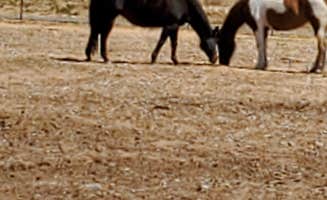Equestrian camping options near Daggett, California offer varied terrain across elevations of 2,000 to 7,000 feet in the San Bernardino Mountains and high desert regions. Summer temperatures often exceed 100°F in the lower elevations, while mountain sites provide cooler conditions. Many horse camping areas require advance planning due to the limited number of equine-friendly facilities and seasonal closures.
What to do
Trail riding at Coon Creek: Access several miles of shaded forest paths connecting to the Pacific Crest Trail system. The routes offer varied terrain for riders of different skill levels. Coon Creek Yellow Post Sites provides convenient access points with "a whole range of sites up and down the dirt road with a good selection of styles from trailer sights to rough camping" according to reviewer Tom P.
Horseback day trips to mountain lakes: Visit Jenks Lake area from the mountains for fishing and scenic rides. Trails from Heart Bar Campground connect riders to these areas. One camper notes "you can drive 10 minutes to Jenks Lake for some fishing and lake views," making it accessible for both day rides and camp stays.
Desert geology exploration: The Rainbow Basin area offers unique geological formations accessible by horseback on designated trails. Rainbow Basin/Owl Canyon Campground serves as a good basecamp with "very cool spot in the Mojave" that provides "every spot level" according to reviewers who explored the area.
What campers like
Wildlife viewing opportunities: The mountain meadows provide excellent wildlife spotting, especially at dusk. Camper Nick L. shares that at Heart Bar Campground you can visit "the beautiful little meadow where deer graze in the evenings," offering natural encounters for riders and their horses.
Access to water features: The combination of desert terrain and occasional water sources creates unique riding experiences. Mojave Narrows Regional Park has "a rockbed forces the normally underground Mojave River to the surface here, meaning that this is one of the only parts of the river to flow above ground year round" according to Megan S., creating a green space in the desert landscape.
Shade availability: Tall pines and native trees provide critical relief from desert sun at higher elevations. At Heart Bar, "The campground is littered with tall standing pines and even some massive junipers, providing ample shade. You can't help but feel like you are elsewhere like the Eastern Sierra."
What you should know
Fire restrictions vary seasonally: Check current fire regulations before planning an equestrian camping trip as restrictions change throughout the year. One visitor to Deep Creek Hot Springs Campground notes they are "basically a patch of dirt you can occupy for $10 a night," but their primitive status means strict adherence to fire safety rules is critical.
Water source planning: Most horse camping areas have limited or no water access for animals. A camper at Coon Creek Yellow Post Sites mentions "Water is only available near the main road so bring containers if you go further up the road," highlighting the need for water transport solutions.
Road conditions impact trailer access: Many access routes require appropriate vehicles for towing horse trailers. A Rainbow Basin visitor warns to prepare for "5 mile washboard road in! Go slow!" when approaching with trailers or RVs.
Cell service varies dramatically: Coverage depends on elevation and surrounding terrain. At Coon Creek, a camper reports "AT&T - Good. 2-4 bars. Verizon - Good. 2-4 bars," but service can disappear completely in canyon areas.
Tips for camping with families
Easy hiking trails: Look for areas with gentle terrain suitable for children and beginner riders. One camper at Hesperia Lake Park and Campground noted the area offers "Water and electric only on camp sites... Nice shade on probably half the sites" making it comfortable for families needing conveniences.
Wildlife education opportunities: The diverse ecosystems provide learning experiences about desert and mountain habitats. However, a visitor cautions about "how many ground squirrels there were! I ended up with two in my tent and one in my van!" - reminding families to secure food and belongings.
Playground access: Some campgrounds offer developed recreation facilities for non-riding family members. Hesperia Lake has "a playground" and "nice views of the lake" though "it's fenced off and access to the lake and park close in the evening."
Weather preparedness: Mountain temperatures can drop significantly at night even when days are warm. At Coon Creek, visitors warn it gets "very cold at night!" requiring appropriate clothing and sleeping gear for all family members.
Tips from RVers
Site leveling challenges: Many equestrian camping areas have uneven terrain requiring leveling equipment. A visitor to Rainbow Basin noted "every spot level, good cell service," making it easier for RV setup than some mountain locations.
Road clearance requirements: High-clearance vehicles are recommended for accessing most horse camping areas. One camper mentioned "Dirt roads were well kept. I came with a 170 wheel base Sprinter Van w/ 2 wheel drive and had no problems making it to site post #11" at Coon Creek Yellow Post Sites.
Shade considerations for RV temperature management: Position RVs to maximize natural shade where available. An RVer at Mojave Narrows noted "level, paved, separated FHU sites with picnic tables and fire rings" but cautioned about limited shade in some areas requiring alternative cooling strategies.
Generator restrictions: Many equestrian camping areas have noise limitations or outright generator bans. Check campground rules before planning an RV trip requiring electrical power.


